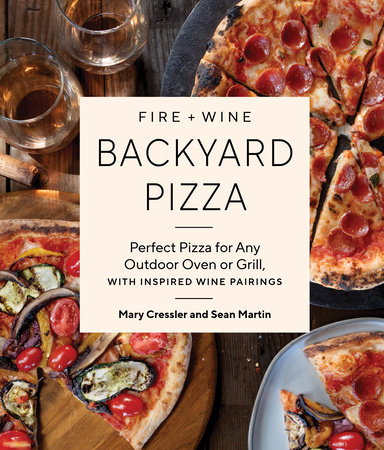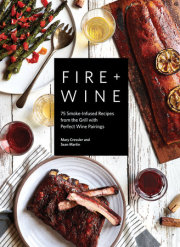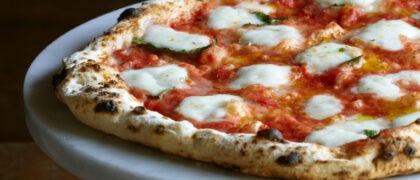MAKING THE DOUGH AND PIZZAAfter your heat and cooking technique, the flour that becomes the dough is the second most important ingredient to understand. There is an incredible variety of books that go deep into the science of pizza dough, like Ken Forkish’s
The Elements of Pizza and
The Pizza Bible by Tony Gemignani. These authors describe why the dough works the way it does, and if you are a serious pizza person, we recommend both those books.
Our book isn’t meant to be a pizza manifesto or baking encyclopedia, but rather a resource for outdoor pizza cooking. For the sake of getting to our recipes, we want to highlight just a few key points.
Flour MattersA great pizza dough starts with good flour. And not all flours are created equal. We aren’t talking just about the specific brand of flour, but about the protein level. In order to achieve the texture and level of gluten (a protein found in wheat) that gives great stretch and cooking ability, the right protein levels are key.
You also need to be able to find and afford the flours that work for your particular needs. Many will jump to “00” flour for pizza, a great flour highly recommended by many experienced pizzaioli. “00” refers to the grind level and grain size, not the protein level. It refers to a flour that has been very finely milled. When buying flour, the type of flour often references a certain range of protein on the package.
The higher the protein levels, the more the gluten strands will connect and create a better texture as the dough ferments and is kneaded. It also allows for more water absorption in the flour. The higher the hydration level, the stickier and denser the flour can become. We knead our dough to help force connection between the proteins. As those connections form and the dough rises, you have the best of both worlds—a strong dough that is difficult to break and will rise further when baking, with a crust that has air pockets and texture you can’t wait to bite into.
Stay away from self-rising flours; they won’t give you the texture and rise since a leavening agent and salt are already added to the flour.
We generally use bread flour, which provides a nice balance in protein and gluten levels. Occasionally we will blend 20 percent “00” flour with bread flour, which does adjust down the protein levels. When we use “00” flour, we use Caputo or King Arthur.
Hydration LevelsWe are now entering full nerd territory, but there’s a very important process to making good dough, especially when you are matching the right dough to your style of grill.
That is the ratio of water to flour, also known as the hydration level, or baker’s percentage. It’s often referred to by pizza nerds like us as a percentage. If you hear the question, “What hydration level was your dough?” you take the total amount of water divided by the total amount of flour. So a 67% hydration dough is 325 grams of water and 500 grams of flour. You can now speak pizza code. You’re welcome.
Hydration affects not only how much dough you make (the higher hydration, the more yield) but also the texture of the crust and how long the dough takes to cook. The higher the hydration level, the denser the dough will become. If you overhydrate a low-protein dough, it gets too sticky to work with. If you underhydrate a high-protein dough, it will be very dry and difficult to work with.
For this book, we use the following hydration levels based on the dough we recommend for your grill or pizza oven.
• NEAPOLITAN-STYLE DOUGH: 67% hydration using bread flour—perfect for your dedicated pizza ovens.
• NEW YORK–STYLE DOUGH: 70% hydration using bread flour—perfect for any grill that isn’t a pizza oven.
• GLUTEN-FREE DOUGH: 80% hydration level using gluten-free flour—perfect for a grill or pizza oven.
For grilled pizzas, it’s especially important to note that the lower your grill heat gets, the more you want hydration in your dough so the pizza doesn’t burn. Dough that has more hydration takes longer to cook as the water boils out, and grilling pizzas takes longer than cooking in a dedicated pizza oven. Making sense?
• Have a Big Green Egg or kettle grill that tops out at 600 degrees F? Consider using a 70–75% hydration dough.
• Using an Ooni or Gozney pizza oven at 900 degrees F? Then consider a 60–67% hydration level.
This ratio is also an important part of knowing how to scale up your recipe. Just keep the ratios and modestly adjust your salt and yeast levels proportionately.
This is why we strongly encourage you to buy a good digital scale, because it’s going to be your friend for making perfectly proportioned dough. It will also allow you to easily adjust how many doughs you want to make. Our recipes are made for three doughs. So if you want to make a single dough, understanding the ratios will help you adjust up and down to any number of doughs you wish to make.
LeaveningAfter choosing the flour, the next important thing is understanding the fermentation process. The best pizza dough recipes allow time for the yeast to activate, feed, and expand the dough. Combined with kneading and forming the gluten strands, the important process of leavening shouldn’t be rushed.
Active dry yeast is best; you add it to lukewarm water so it has the ideal temperature to “wake up” and start the feeding process. If the water is too hot, it will kill the yeast. If it’s too cool, it dramatically slows the fermentation process.
We recommend the water be warmed between 90 and 110 degrees F (32 and 43 degrees C).
FIRST RISE. Also referred to as the bulk rise, or fermentation. The first rise is like waking up the yeast and introducing it to the party in the flour. It starts as you feed the yeast with warm water and combine it with the dry ingredients. It expands the dough as the yeast feeds.
SECOND RISE. While you can technically roll out the first-rise Dough into dough balls, adding a second fermentation period allows the yeast to continue to feed while you connect those gluten strands for great dough texture as you knead the dough. The second rise is when we’ve formed the individual dough balls from the first rise.
We recommend you plan for both the bulk fermentation and the secondary proofing of your dough; don’t skip this step! Ideally plan a minimum of 5 hours at room temperature (at least 70 degrees F, or 21 degrees C) to get the right amount of rise and texture.
WHY KNEAD? As we mentioned, by pressing, folding, and pushing on your dough, you are forcing the proteins to combine and create an intricate highway of gluten strands. If you were to pull apart a well-kneaded dough, you will see strands that look like spiderwebs, so it’s key to make sure you knead. The exception is working with gluten-free dough, which is an entirely different beast (more on that later).
If making a same-day dough, the dough will rise if the ambient temperature of your home is between 70 and 80 degrees F (21 and 26 degrees C). If it’s cooler than that, a great hack is to turn on just the light in your oven. Then place your fermenting dough in the oven while the light is on, which will keep the dough just warm enough. If your home is cooler, it takes longer for the rising to happen.
If your home is hotter, then you may run the risk of overproofing. If your home temperature is over 80 degrees, monitor your dough to see if it’s expanding too fast after the second rise. If that is happening, knead the dough balls again to tighten them up after the second fermentation. Just don’t do this less than 60 minutes prior to making pizza, as the dough balls need to settle to have those important air pockets.
If you are letting your dough rise in the refrigerator for 24–48 hours, then make the dough through the first fermentation process as noted. When you break down the larger dough balls into individual-sized balls, roll them tight and pinch them to create a solid dough. Then place in a dough proofing container or a sheet tray covered in plastic wrap.
Cold fermentation in the refrigerator has a few benefits. First, it slows down the proofing process, which minimizes overproofing or the formation of huge bubbles. Second, it allows more time for the yeast to work its magic, leading to a more airy crust with more flavor.
Our recommendation is to give your dough 24 hours: 2 hours for the bulk fermentation at room temperature and then secondary proofing as dough balls in the refrigerator. Then remove from the refrigerator 2 hours before using so they aren’t too cold to work with when forming the pizza rounds. But if you do wake up wanting dough that same day, give yourself a minimum of 5 hours.
SAMPLE RECIPES
DEEP-DISH PIZZAThe inspiration for this pizza is definitely Chicago. Making deep-dish pizza can be a technical challenge in a pizza oven due to the amount of time it takes to bake a Chicago-style
crust. We recommend baking this pizza on a grill to give the crust time to firm up and to allow the pizza to cook all the way through. It also needs more dough than our typical pizzas.
When making the dough, and going through the second rise, instead of dividing into three dough balls, we divide into two. The first dough ball will be around 280 grams (perfect for all the
individual pizzas in this book), and the second (a double size) will be a little over 600 grams. Knead, form, and rise the second ball the same way; it just weighs more and will be able to stretch out for the size of the pie pan used.
YIELD: ONE 10-INCH CAST-IRON PIZZA
Equipment:
10-inch cast-iron pan or deep-dish pizza pan
1 tablespoon unsalted butter
1 pizza dough (600–620 g) (page XX)
6 slices provolone cheese
6 slices (or XX cups shredded) low-moisture mozzarella
1/2 pound Italian sausage, ground
1/2 cup green bell pepper, diced
11/2 cups Marinara Sauce (page XX)
1/4 cup Parmigiano-Reggiano, grated
1 Preheat your grill so the pizza stone is at 500 degrees F.
2 Form your dough into a round 13 inches wide on a floured surface, following the instructions on page XX.
3 Move the prepared dough round to a well-buttered 10-inch cast-iron pan. Press the dough into the base and up along the sides of the pan.
4 Layer on the provolone cheese slices, overlapping them. Then do the same with the mozzarella. Add small chunks of the sausage, then the bell pepper. Cover with the sauce, evening it out with the back of a spoon. Sprinkle the Parmigiano-Reggiano over the sauce.
5 If there is excess dough hanging off the edges of the pan, remove it with a knife and pinch the excess dough over the rim so it doesn’t sink back.
6 Transfer the pizza to your grill and bake for up to 25 minutes. The dough should be browned and slightly pulled back from the edges of the pan.
7 After removing the pizza, let it rest for 10 minutes. Then, using a large spatula and your hands, carefully remove the pie from the pan onto a cutting board. Cut into wedges and enjoy.
WINE PAIRING: This is a big and rich pizza, laden with layers of cheese, spicy sausage, and a thick red sauce. Let’s go with something to match the richness: syrah. This is a strong match for the fennel-driven spicy sausage, and has good tannins and acidity to stand up to the cheeses and acidic sauce. Similarly, you could choose a rich mourvèdre or grenache. Both would be delicious!
BBQ PULLED PORK PIZZAIf you own a smoker or grill, we expect you to have some pulled pork left over from time to time. This is a great way to use it up! Pork dries out in the fridge, so we like to warm it up and rehydrate it in a pan with some BBQ sauce or apple cider vinegar before adding it to the pizza. Use your favorite Kansas City–style BBQ sauce as a base (or opt for our Pinot Noir BBQ Sauce, found at Vindulge.com), and build your masterpiece. We recommend you cook this one on the grill, as it is a little heavier than what we like for a dedicated pizza oven and cooks a little slower, which integrates the flavors.
YIELD: ONE 12-INCH PIZZA
1/3 cup Kansas City–style BBQ sauce, plus 2 tablespoons
3/4 cup leftover pulled pork, shredded
1 pizza dough (we recommend the All-Purpose New York-Inspired Dough for this, page XX)
1/3 cup low-moisture mozzarella, shredded
1/3 cup sharp cheddar cheese, shredded
1/4 cup Quick Pickle Jalapeños (recipe follows)
1/4 cup red onion, thinly sliced
1/4 cup cilantro, chopped
Pinch of finishing salt
1 Preheat your grill to your target temperature per the instructions on pages XX and XX.
2 In a small saucepan over medium heat, add 2 tablespoons of the BBQ sauce and the leftover pulled pork. Stir to warm up and rehydrate, about 6 minutes.
3 Form your dough into a round 11–12 inches wide on a floured surface, following the instructions on page XX.
4 Move the prepared dough round to a floured pizza peel.
5 On your pizza round, spread the BBQ sauce within 1/2 inch of the rim, then layer on the pulled pork, cheeses, jalapeños, and onion.
6 Transfer the pizza to your grill and bake per the instructions on page X.
7 After removing the pizza, coat with the cilantro and finishing salt.
NOTE: Warm up the pork in advance so it’s not blazing hot when you add it to the pizza. If it’s too hot, it will warm your dough and make it stick to the peel. It’s a fine balance to warm and rehydrate the pork without making it too hot.
WINE PAIRING: Classic BBQ flavors call for a classic wine pairing. The smoky and savory pork, with the rich BBQ sauce flavors, is always a great match for bold, fruity wines like syrah or zinfandel.
Quick Pickle Jalapeños1/2 cup water
1/4 cup white vinegar
1/4 cup cane sugar
1/2 cup jalapeños, thinly sliced
In a small saucepan over medium heat, combine the water, vinegar, and sugar. Stir together and bring to a simmer. Add the jalapeños and simmer for 10 minutes. Turn off the heat and let rest for 10 more minutes. Store in a mason jar in the refrigerator for up to 10 days.
Copyright © 2025 by Mary Cressler and Sean Martin. All rights reserved. No part of this excerpt may be reproduced or reprinted without permission in writing from the publisher.



















